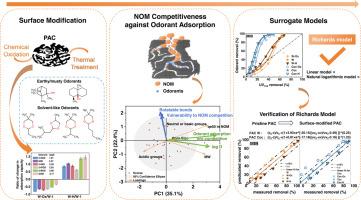当前位置:
X-MOL 学术
›
Water Res.
›
论文详情
Our official English website, www.x-mol.net, welcomes your
feedback! (Note: you will need to create a separate account there.)
Competition & UV254 projection in odorants vs natural organic matter adsorption onto activated carbon surfaces: Is the chemistry right?
Water Research ( IF 11.4 ) Pub Date : 2024-11-07 , DOI: 10.1016/j.watres.2024.122764 Fang Liu, Qi Wang, Frederik Zietzschmann, Fan Yang, Shaozhen Nie, Junzhi Zhang, Min Yang, Jianwei Yu
Water Research ( IF 11.4 ) Pub Date : 2024-11-07 , DOI: 10.1016/j.watres.2024.122764 Fang Liu, Qi Wang, Frederik Zietzschmann, Fan Yang, Shaozhen Nie, Junzhi Zhang, Min Yang, Jianwei Yu

|
Powdered activated carbon (PAC) adsorption remains an indispensable method for addressing odor problems in drinking water. While natural organic matter (NOM) is ubiquitous and competes strongly in deteriorating odorant adsorption capacity, it can also serve as a promising indicator for predicting odorant adsorption through online measurement. However, the impact of PAC surface chemistry on NOM competition and feasibility of prediction across various adsorbents are not well understood. Here, we examined the role of PAC properties (pore structure and surface chemistry) in the competitive adsorption between odorants and NOM components, aligned with the applicability assessment of using NOM optical properties for odorant adsorption projection across various PAC samples. Chemical oxidation and thermal treatment achieved considerable changes in surface functional group composition, alongside minimal changes in pore structure, of two typical PAC products with microporous/mesoporous pore characteristics. The effect of NOM interference on the reduction of odorant adsorption exhibited a similar level regardless of the PACs with different pore structure (average pore size of 1.7 nm vs. 4.2 nm). Surface modification increased the equilibrium adsorption capacity (qe50) of odorants by 15.1 % to 146.4 % (thermal treatment) or decreased by -81.3 % to -34.1 % (chemical oxidation), respectively, but minimal changes in odorant-NOM selectivity. For various odorants, hydrophobicity (log D) influenced the adsorption capacity while the structural flexibility (reflected by the rotatable bonds) affected the vulnerability of odorant adsorption to NOM competition. It was found for the first time that four-parameter Richards model (RMSE = 2.6 %) is superior to the linear model (RMSE = 12.5 %) or logarithmic model (RMSE = 77.6 %) to describe the S-shape UV254 projection curves associated with odorant adsorption on PAC. Moreover, the feasibility was confirmed to use UV254 projection curves of pristine PAC fitted with the Richards model to predict the odorant adsorption on surface-modified PAC in two different surface waters (RMSE 9.2 % and 7.4 %, respectively). This study provides insight into the role of PAC surface chemistry and pore characteristics in odorant adsorption in NOM-containing waters and enhances the feasibility of the NOM surrogate model for odorant monitor and control during PAC adsorption.
中文翻译:

竞争和UV254在气味剂中的投射与活性炭表面的天然有机物吸附:化学反应正确吗?
粉末活性炭 (PAC) 吸附仍然是解决饮用水中异味问题不可或缺的方法。虽然天然有机物 (NOM) 无处不在,并且在恶化的加臭剂吸附能力方面具有很强的竞争力,但它也可以作为通过在线测量预测加臭剂吸附的有前途的指标。然而,PAC 表面化学对 NOM 竞争的影响和对各种吸附剂的预测可行性尚不清楚。在这里,我们研究了 PAC 特性(孔隙结构和表面化学)在加臭剂和 NOM 组分之间的竞争吸附中的作用,与使用 NOM 光学特性在各种 PAC 样品中进行加臭剂吸附投影的适用性评估一致。化学氧化和热处理使两种具有微孔/介孔特性的典型 PAC 产品的表面官能团组成发生了相当大的变化,同时孔隙结构的变化最小。无论具有不同孔结构的 PAC (平均孔径为 1.7 nm 对 4.2 nm),NOM 干扰对减少加臭剂吸附的影响都表现出相似的水平。表面改性使加臭剂的平衡吸附能力 (qe50) 分别提高了 15.1 % 至 146.4 %(热处理)或降低了 -81.3 % 至 -34.1 %(化学氧化),但加臭剂-NOM 选择性的变化很小。对于各种加臭剂,疏水性 (log D) 影响吸附能力,而结构柔韧性 (反映在可旋转键上) 影响加臭剂吸附对 NOM 竞争的脆弱性。首次发现四参数 Richards 模型 (RMSE = 2.6 % 优于线性模型 (RMSE = 12.5 %) 或对数模型 (RMSE = 77.6 %) 来描述与 PAC 上气味剂吸附相关的 S 形 UV254 投影曲线。此外,使用原始 PAC 的 UV254 投影曲线拟合 Richards 模型来预测两种不同表层水中表面改性 PAC 上的气味吸附(分别为 RMSE 9.2 % 和 7.4%),证实了可行性。本研究深入了解了 PAC 表面化学和孔隙特性在含 NOM 的水中气味吸附中的作用,并增强了 NOM 替代模型在 PAC 吸附过程中气味监测和控制的可行性。
更新日期:2024-11-07
中文翻译:

竞争和UV254在气味剂中的投射与活性炭表面的天然有机物吸附:化学反应正确吗?
粉末活性炭 (PAC) 吸附仍然是解决饮用水中异味问题不可或缺的方法。虽然天然有机物 (NOM) 无处不在,并且在恶化的加臭剂吸附能力方面具有很强的竞争力,但它也可以作为通过在线测量预测加臭剂吸附的有前途的指标。然而,PAC 表面化学对 NOM 竞争的影响和对各种吸附剂的预测可行性尚不清楚。在这里,我们研究了 PAC 特性(孔隙结构和表面化学)在加臭剂和 NOM 组分之间的竞争吸附中的作用,与使用 NOM 光学特性在各种 PAC 样品中进行加臭剂吸附投影的适用性评估一致。化学氧化和热处理使两种具有微孔/介孔特性的典型 PAC 产品的表面官能团组成发生了相当大的变化,同时孔隙结构的变化最小。无论具有不同孔结构的 PAC (平均孔径为 1.7 nm 对 4.2 nm),NOM 干扰对减少加臭剂吸附的影响都表现出相似的水平。表面改性使加臭剂的平衡吸附能力 (qe50) 分别提高了 15.1 % 至 146.4 %(热处理)或降低了 -81.3 % 至 -34.1 %(化学氧化),但加臭剂-NOM 选择性的变化很小。对于各种加臭剂,疏水性 (log D) 影响吸附能力,而结构柔韧性 (反映在可旋转键上) 影响加臭剂吸附对 NOM 竞争的脆弱性。首次发现四参数 Richards 模型 (RMSE = 2.6 % 优于线性模型 (RMSE = 12.5 %) 或对数模型 (RMSE = 77.6 %) 来描述与 PAC 上气味剂吸附相关的 S 形 UV254 投影曲线。此外,使用原始 PAC 的 UV254 投影曲线拟合 Richards 模型来预测两种不同表层水中表面改性 PAC 上的气味吸附(分别为 RMSE 9.2 % 和 7.4%),证实了可行性。本研究深入了解了 PAC 表面化学和孔隙特性在含 NOM 的水中气味吸附中的作用,并增强了 NOM 替代模型在 PAC 吸附过程中气味监测和控制的可行性。


















































 京公网安备 11010802027423号
京公网安备 11010802027423号